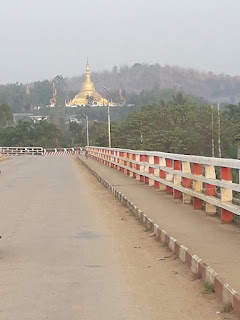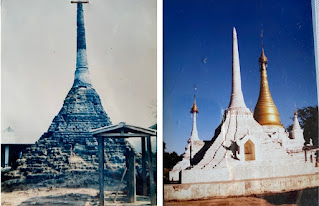N 129 My childhood days in Kunhing. I was born in Kunhing in Southern Shan State which is 140 miles from Taunggyi ,the capital of the State. When I was about 5 years old our family moved to Taunggyi for some reasons . In those days cars were not very plentiful. So to go to Taunggyi we had to rely on some lorries which transported people and goods to Kengtung, and maybe there were a few jeeps too. Like many other people who moved away but couldn’t forget their birthplace, we the children would like to visit Kunhing whenever we had a chance,though it was not even a town where many people resided,but a few houses scattered here and there. In the early years my grandmother was still alive, so we had grandmother and an aunt with her family to stay with.
(Front row left to right : mother's elder sister, unknown, mother's mother, mother) They would dote on us , children, with special foods they have. We ate sticky rice with fried fresh carp from Nam Pang river. The fishes caught from Nam Pang river then were so delicious, because they were natural. Fried pork or some fermented meat with sticky rice was also a common food . On market days when we entered the small market our nostrils were met by the smell of Shan mount ti. We ate this with eggs and fried dried pork skin. Eggs in those days were natural and they were sold by putting in small woven bamboo strips. There were also other Shan snacks like Khao moon part , khao moon haw and some other khao moons.
The other attraction of Kunhing is the Nam Pang stream. Though it is called stream it actually is as big as a river with its head in Mernghsu, a town north of Kunhing. It may be about 300 yards at its widest and would be deep because of its emerald green color. There was a wooden bridge across it in those days with some space between the planks that it was frightful for us children to look down to the water.
As long as I can remember, nobody swam across the stream. But I heard that my mother when she was young swam across it, but surely with company, which would be her cousins. I learned that they swam not the whole length in one stroke, but rest on boulders which are plentiful in the stream. And my mother and her cousins when they did boating in the stream would be reckless enough to choose the smallest boats. They were young and could swim well then , and if something happen help would surely come from nearby. We children never had opportunity to bathe ,to swim in the Nam Pang river. Our bathing time was in the evening ,when we were taken to a small waterfall made by some planks to have water from a small stream flow down to a lower place, where we bathe under it. There also was a platform made of thick wooden planks to wash and do washing clothes .There also was a rice mill with a waterwheel near there, which was running night and day. We children were happy and satisfied to go and bathe at this small waterfall and would be looking to the time to go there.
Kunhing is hot as it is only 1615 feet above sea level with no high mountains. I recalled a unique way of how we kept cool during the summer months while we were there. A big bamboo mat which maybe about 8 or 10 feet ,bounded by bamboo strips at the edges were secured to a beam by ropes was let hanging down. This mat was pulled backwards and forwards by maids to let cool air fill the space while family members sit or lie down on the floor mat. I never saw this way of keeping cool anywhere,but only there in those days. As I mentioned earlier Kunhing is 140 miles away from Taunggyi. Even there were no effective means of traveling in the early days ,for some reasons people were going places. Around 1930, when my mother was at the age of 15/16 she travelled to Taunggyi with her mother . I learned that the two of them traveled in a bullock cart with only the cart driver as their company. At night they slept in the cart while the driver slept on the ground. My mother who was dubbed “Golden Tree “because she always wear heavy jewelry, would then be wearing jewelry ,but the country under British rule by then was peaceful with no robbers or dacoits ,that they had nothing to fear of. The journey took them 10 days to reach Taunggyi.
Even in my mother’s time I think the road between Taunggyi and Kunhing was paved with asphalt. The author Morris Collision seemed to reach Kunhing in one day, and then next day he even reached Kengtung riding in lorries. The road between Kunhing and Taunggyi sometimes passes through lowlands, though there are curves and bends occasionally, but after Loilem the region is mountainous, that it is dangerous for cars to pass through. On one side are massive rock walls that cannot be blown to widen the road, and on the other side deep precipices, where sometimes cars fall down and caused casualties.
The name Kunhing comes from the word Kunhing which means a thousand islands, because there are many islands in the Nampang Stream. After my grandparents time more people came and settled on the west bank and gradually it grew to become a town. As for now it had became an important town because of its location, which is on the Asian Road, the capital of a township with departmental offices and a fair population.

.jpg)














